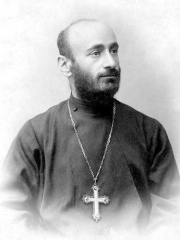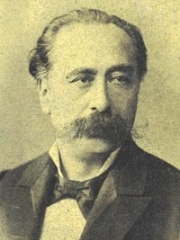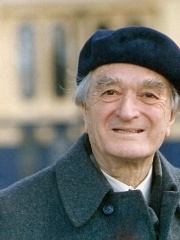




The Most Famous
COMPOSERS from Turkey
Top 6
The following people are considered by Pantheon to be the most legendary Turkish Composers of all time. This list of famous Turkish Composers is sorted by HPI (Historical Popularity Index), a metric that aggregates information on a biography’s online popularity.

1. Komitas (1869 - 1935)
With an HPI of 63.50, Komitas is the most famous Turkish Composer. His biography has been translated into 47 different languages on wikipedia.
Soghomon Soghomonian, ordained and commonly known as Komitas (Armenian: Կոմիտաս; 8 October [O.S. 26 September] 1869 – 22 October 1935), was an Ottoman-Armenian priest, musicologist, composer, arranger, singer, and choirmaster, who is considered the founder of the Armenian national school of music. He is recognized as one of the pioneers of ethnomusicology. Orphaned at a young age, Komitas was taken to Etchmiadzin, Armenia's religious center, where he received education at the Gevorgian Seminary. Following his ordination as vardapet (celibate priest) in 1895, he studied music at the Frederick William University in Berlin. He thereafter "used his Western training to build a national tradition". He collected and transcribed over 3,000 pieces of Armenian folk music, more than half of which were subsequently lost and only around 1,200 are now extant. Besides Armenian folk songs, he also showed interest in other cultures and in 1903 published the first-ever collection of Kurdish folk songs titled Kurdish melodies. His choir presented Armenian music in many European cities, earning the praise of Claude Debussy, among others. Komitas settled in Constantinople in 1910 to escape mistreatment by ultra-conservative clergymen at Etchmiadzin and to introduce Armenian folk music to wider audiences. He was widely embraced by Armenian communities, while Arshag Chobanian called him the "savior of Armenian music". During the Armenian genocide—along with hundreds of other Armenian intellectuals—Komitas was arrested and deported to a prison camp in April 1915 by the Ottoman government. He was soon released under unclear circumstances and, having witnessed indiscriminate cruelty and relentless massacres of other Armenians by the Ottoman Turks, Komitas experienced a mental breakdown and developed a severe case of post-traumatic stress disorder (PTSD). The widespread hostile environment in Constantinople and reports of mass-scale Armenian death marches and massacres that reached him further worsened his fragile mental state. He was first placed in a Turkish military-operated hospital until 1919 and then transferred to psychiatric hospitals in Paris, where he spent the last years of his life in agony. Komitas is widely seen as a martyr of the genocide and has been depicted as one of the main symbols of the Armenian Genocide in art. Collection of Works of the Composer Komitas Vardapet is included to UNESCO Memory of the World Register.

2. Aristides Quintilianus (150 - 250)
With an HPI of 52.78, Aristides Quintilianus is the 2nd most famous Turkish Composer. His biography has been translated into 15 different languages.
Aristides Quintilianus (Greek: Ἀριστείδης Κοϊντιλιανός) was the Greek author of an ancient musical treatise, Perì musikês (Περὶ Μουσικῆς, i.e. On Music; Latin: De Musica) According to Theodore Karp, his three-volume work on music "constitutes one of the principal sources of modern knowledge of ancient Greek music and its relationship to other disciplines". According to the 17th-century scholar Marcus Meibomius, in whose collection (Antiq. Musicae Auc. Septem, 52) this work was printed for the first time in 1652, it contains everything on music that is to be found in antiquity. The dates of Aristides are uncertain. In his book he refers to Cicero (d. 43 BC), and his work was used by Martianus Capella (fl. 410-420). According to Thomas J. Mathiesen, Aristides flourished in the late 3rd or early 4th century AD. One piece of evidence for Aristides' date, according to Winnington-Ingram, is that fact in the work he addresses two friends called Eusebius and Florentius; the latter name is unknown before AD 300. Book 1 of the work deals with the theory of music under the traditional headings of harmonics, rhythm, and metre. It depends heavily on Aristoxenus (4th century BC), but with some "intriguing additions", apparently from a source from the classical period. Book 2 (said by Winnington-Ingram to be "extremely interesting") discusses the importance of music in the education of the young and in the moral life of individuals. Book 3 discusses the arithmetic of music and explores from the point of view of Platonic philosophy the analogies between numbers in music and numbers in the physical world.

3. Tigran Chukhajian (1837 - 1898)
With an HPI of 50.40, Tigran Chukhajian is the 3rd most famous Turkish Composer. His biography has been translated into 17 different languages.
Tigran Gevorki Chukhajian (Armenian: Տիգրան Չուխաճեան; Turkish: Dikran Çuhacıyan; 1837 – March 11, 1898) was an Ottoman Armenian composer and conductor, and the founder of the first opera institution in the Ottoman Empire.

4. Ahmet Adnan Saygun (1907 - 1991)
With an HPI of 49.47, Ahmet Adnan Saygun is the 4th most famous Turkish Composer. His biography has been translated into 21 different languages.
Ahmet Adnan Saygun (Turkish pronunciation: [ahˈmet adˈnan sajˈɡun]; 7 September 1907 – 6 January 1991) was a Turkish composer, musicologist and writer on music. One of a group of composers known as the Turkish Five who pioneered western classical music in Turkey, his works show a mastery of Western musical practice, while also incorporating traditional Turkish folk songs and culture. When alluding to folk elements he tends to spotlight one note of the scale and weave a melody around it, based on a Turkish mode. His extensive output includes five symphonies, five operas, two piano concertos, concertos for violin, viola and cello, and a wide range of chamber and choral works. The Times called him "the grand old man of Turkish music, who was to his country what Jean Sibelius is to Finland, what Manuel de Falla is to Spain, and what Béla Bartók is to Hungary". Saygun was growing up in Turkey when he witnessed radical changes in his country’s politics and culture as the reforms of Mustafa Kemal Atatürk had replaced the Ottoman Empire—which had ruled for nearly 600 years—with a new secular republic based on Western models and traditions. As Atatürk had created a new cultural identity for his people and newly founded nation, Saygun found his role in developing what Atatürk had begun.

5. Manolis Kalomiris (1883 - 1962)
With an HPI of 46.20, Manolis Kalomiris is the 5th most famous Turkish Composer. His biography has been translated into 16 different languages.
Manolis Kalomiris (Greek: Μανώλης Καλομοίρης; December 14, 1883, Smyrna – April 3, 1962, Athens) was a Greek classical composer. He was the founder of the Greek National School of Music.

6. Necil Kazım Akses (1908 - 1999)
With an HPI of 44.65, Necil Kazım Akses is the 6th most famous Turkish Composer. His biography has been translated into 19 different languages.
Necil Kazım Akses (May 6, 1908 – February 16, 1999) was a Turkish classical composer.
Pantheon has 6 people classified as composers born between 150 and 1908. Of these 6, none of them are still alive today. The most famous deceased composers include Komitas, Aristides Quintilianus, and Tigran Chukhajian. As of April 2022, 1 new composers have been added to Pantheon including Aristides Quintilianus.
Deceased Composers
Go to all Rankings
Komitas
1869 - 1935
HPI: 63.50
Aristides Quintilianus
150 - 250
HPI: 52.78
Tigran Chukhajian
1837 - 1898
HPI: 50.40
Ahmet Adnan Saygun
1907 - 1991
HPI: 49.47
Manolis Kalomiris
1883 - 1962
HPI: 46.20
Necil Kazım Akses
1908 - 1999
HPI: 44.65

Newly Added Composers (2022)
Go to all RankingsWhich Composers were alive at the same time? This visualization shows the lifespans of the 5 most globally memorable Composers since 1700.





